
Commercialization of Christmas holiday is nothing new
12/21/2014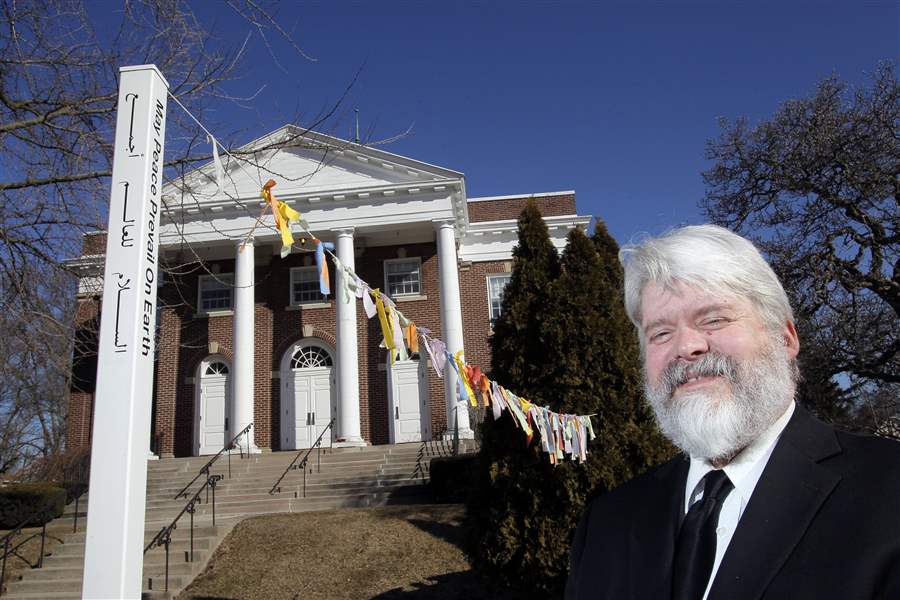
Rev. Ed Heilman of Park Congregational Church in South Toledo says ‘the appropriation of Christ has a long history.’
The Blade
Buy This Image
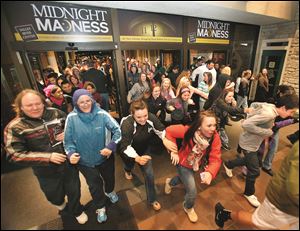
A national survey recently found 33 percent of people said they don’t like the commercialism and materialism and 22 percent don’t like the money aspect and expense.
When did the Christmas season become so commercial?
That’s a common question from nostalgic adults. It isn’t a children’s question — kids are experiencing the wonder of the holidays, having little discord in hearing the story of the baby Jesus and then asking what Santa will bring them.
For many adults, radios playing Christmas music 24/7 from Thanksgiving or even before, a phenomenon that started in the late 1980s or early ’90s, sets off their personal commercial alarms. The campouts and injuries at store openings on Black Friday indicate there’s too much business over religion for some. As Christmas decorations creep closer to Halloween, the “when did it change” question arises.
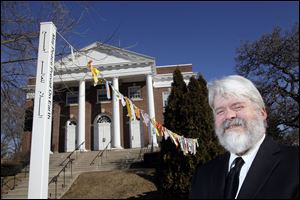
Rev. Ed Heilman of Park Congregational Church in South Toledo says ‘the appropriation of Christ has a long history.’
The Rev. Ed Heilman of Park Congregational Church, 1456 Harvard Blvd. in South Toledo, said, “The appropriation of Christ has a long history, and so to try to retain the integrity of what it means to be a follower of Christ is a part of the birth story, and that’s as old as Jesus himself.”
Alison Hudson, a blogger in Dearborn, Mich., who has written about Christmas commercialization on the websites Skeptoid and the Secular Web, mentioned the anti-commercialization messages from Christmas TV shows she watched as a child, A Charlie Brown Christmas and How the Grinch Stole Christmas. The programs came out in the mid-1960s so, she realized, “people were complaining about commercialization 50 years ago.”
“I can find sources from the late 19th century saying that Christmas isn’t the same as it used to be,” said Penne Restad, a lecturer at the University of Texas at Austin and author of Christmas in America: A History. “I’m wondering if it isn’t a lament of adulthood. … Christmas is one of the ways that we mark that we’re no longer children; that’s sad, isn’t it?”
“You could probably read stuff from 1,000 years ago that says Christmas isn’t what it used to be,” Pastor Heilman said.
American Christmas traditions that we think of fondly, including trees and Santa and Christmas presents, started in the 19th century in homes and churches, according to Ms. Restad’s book, although venerating trees for the winter solstice predated Christianity, and Santa Claus has a connection to St. Nicholas of Myra, who died around the year 335.
Nineteenth-century Christmas revelry “frequently spilled into the public realm,” Ms. Restad wrote. And, she noted, people were stressed out even then by Christmas shopping.
Sacred and secular
Before the 19th century, “Puritan fustiness,” as Ms. Restad called it, limited the observance of Christmas. Many church-connected people did not celebrate Dec. 25 because it wasn’t in the Bible. But the commerce element established a presence.
Since the 1800s, the connections between Santa Claus and Christmas trees and newborn Jesus in a manger bridged commerce and faith. Over time, the spiritual element began to get lost in the celebration.
“Commercial is always going to be there, and we’re always going to hate it,” Ms. Hudson said. Since the time of Charles Dickens and his book A Christmas Carol in 1843, she said, the holiday has continued to grow in its commercial aspect, but “it’s always been commercialized to some degree.”
How much has culture taken from the church for Christmas?
In December, 2013, the Pew Research Center’s Religion & Public Life Project reported that almost 93 percent of Americans celebrate Christmas, according to a survey of 2,001 adults, but only about 75 percent of those surveyed identified as Protestant or Catholic.
About one-third of Americans said the holiday is more cultural than religious — but 54 percent said they planned to attend Christmas religious services.
Eight out of 10 non-Christians in America celebrate the holiday, Pew found, including 87 percent of those who don’t have a religious affiliation.
Ms. Hudson suggested that today “Christmas is not so much a religious holiday as it is a cultural holiday with a religious aspect. I can enjoy all the traditional aspects of Christmas without having to go to church.”
Christmas trees
Take, for example, the Christmas tree, which in the United States began as an in-home fixture. It has become the symbol of the cultural holiday, but many overlook its pagan origins.
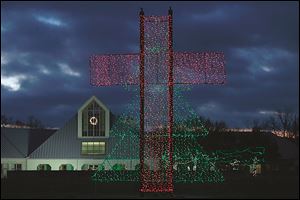
The Church on Strayer in Maumee erected a ‘Cross-mas Tree,’ a light display of a 30-feet-high red cross superimposed over a green tree outline.
Seventy-nine percent of Americans, including non-Christians, planned to put up a Christmas tree in 2013, Pew said, but 92 percent said they had trees as children. An earlier Pew survey stated that 32 percent of Jews had a Christmas tree in their house in 2012.
Rabbi Samuel Weinstein of Temple Shomer Emunim in Sylvania said by email, “I recognize that some Jews do not want to feel separated from society at this season, but simply put, the Christmas tree is not our symbol. Even if Christmas is highly commercialized by our society, I do not feel that we as Jews should contribute to the secularization of Christmas by making Christmas something it is not.
“Obviously, interfaith families need to adopt practices for their family and that may include the tree, but even in that environment, the true meaning of the tree can be explained.”
Jay Rinsen Weik Sensei is the abbot of the Buddhist Temple of Greater Toledo, and he and his wife, the Rev. Karen Do’on Weik, also a Buddhist priest, have a Christmas tree in their home.
“The tree, the music, and the gifts are fun,” he said in an email, “but mostly for us [the holiday season] is about spending family time together, appreciating our lives, and being grateful for the experience of life. … It would not be odd for members of the Buddhist Temple of Toledo community to start [Christmas] day with a tip of the hat and offering some incense to Jesus on the day that the world celebrates his birth.”
And they would likely exchange gifts.
Today, “there seems to be more expectation of how much is under the tree,” Ms. Hudson said, at least for her three children. “I think kids nowadays, they certainly expect more at Christmas than people used to, not just in terms of quantity, but specificity.” As in, the right brands or precise features. “To get people exactly what they want, that changes the nature of everything.” It’s more order fulfillment than gift-giving, she noted.
Holy commerce
In the Pew survey, people were asked what they looked forward to most, and what they like least, about Chrsistmas and the holidays. They could give more than one answer. Only 11 percent most looked forward to religious reflection and church, while 6 percent liked least the removal of religion and Christ from the holidays, and 2 percent didn’t like that they have to go to church.
The highest reported “like” percentage was that 69 percent look forward to time with family and friends, while on the “don’t like” list, 33 percent said they don’t like the commercialism and materialism, 22 percent don’t like the money aspect and expense, and 10 percent don’t like shoppng, crowds, and crowded stores (1 percent most looked forward to shopping and good deals).
There have been efforts to reclaim the commercial by folding it into religious celebration, from having trees in church, as Ms. Restad said started in the 1800s, to the recent sculptures of Santa in nativity scenes adoring the baby Jesus.
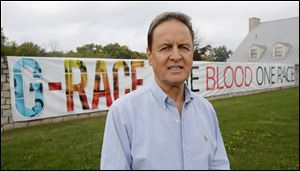
Rev. Tony Scott of the Church on Strayer, which sponsors the Noel Project to give Christmas gifts to families in need.
The Rev. Tony Scott of the Church on Strayer, which sponsors the Noel Project to give Christmas gifts to families in need, erected a “Cross-mas Tree” at his church, a light display of a 30-feet-high red cross superimposed over a green tree outline. He intends to keep the structure up and lit until Easter, when the cross is the predominant religious symbol.
Pastor Scott said that Jesus “is indeed the light of the world. The Tree of Life is given to us in the garden of Eden, so the ‘Cross-mas Tree’ symbolizes God giving back to fallen man life eternal.”
Pastor Heilman said, “The hope that I have is the gospel text from John, ‘the light shines into the darkness, and the darkness does not overwhelm it,’ so the idea is that Christmas cannot ultimately be stolen or appropriated. Christ continues to break through.”
“What Christmas can be and is for a lot of people,” Ms Restad said, “is that it is something to get the family together. ... Maybe you don’t need the religion; you need the magnetism. It’s the need for connection, and in any case, all those things that we see, even Santa Claus, could be seen as sort of really pale versions, replicas, of some much greater spiritual connection.”
Contact TK Barger at: tkbarger@theblade.com, 419-724-6278 or on Twitter @TK_Barger.